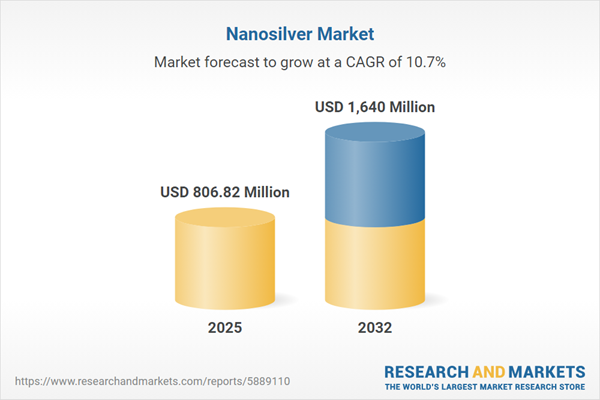Speak directly to the analyst to clarify any post sales queries you may have.
The nanosilver market empowers organizations to navigate regulatory shifts, strengthen product integrity, and improve operational responsiveness in highly regulated sectors. This report presents a comprehensive analysis for senior decision-makers seeking strategic clarity and actionable direction in an evolving global landscape.
Market Snapshot: Nanosilver Market Size and Growth Trajectory
The global nanosilver market is experiencing steady adoption as regulatory standards and performance expectations increase across manufacturing, healthcare, electronics, and consumer product sectors. Current research indicates that the market will grow from USD 727.80 million in 2024 to USD 806.82 million in 2025, ultimately reaching USD 1.64 billion by 2032 at a CAGR of 10.72%. This sustained expansion underscores a heightened enterprise focus on risk mitigation, regulatory alignment, and quality enhancement amidst intensifying global supervision and safety requirements.
Nanosilver Market Scope & Segmentation
- Applications: Nanosilver is embedded in antimicrobial paints, self-cleaning coatings, personal care solutions, battery system components, food packaging, hygiene technologies for medical devices, engineered textiles, athletic wear, water treatment, and a range of home goods. These uses highlight its value for performance gains and regulatory compliance across diverse end markets.
- Product Types: Organizations can obtain nanosilver in coatings (applied by dip or spray), as colloidal nanosilver differentiated by particle size (below 20 nm, 20–50 nm, and above 50 nm), and powders suitable for industrial or laboratory use. Each form supports specific process needs and technical requirements.
- End User Industries: Principal adopters span construction for commercial and residential properties, electronics and appliances manufacturing, healthcare service providers, water treatment facilities, and producers of various consumer goods. These enterprises leverage nanosilver to uphold product reliability in dynamic regulatory environments.
- Distribution Channels: Sourcing options include direct engagement with producers, partnerships with regional distributors, collaborations with major retailers, and procurement through specialized e-commerce platforms. These multiple avenues support tailored sourcing strategies and logistical alignment based on operational and geographic priorities.
- Regional Coverage: Robust supply chains facilitate access in North and South America, Europe, the Middle East, Africa, and Asia-Pacific. Primary markets such as the United States, Canada, China, Japan, India, Western Europe, Latin America, and select regions in the Middle East are well served, supporting dependable delivery for enterprise procurement strategies.
- Key Companies: Technological advancements and supply reliability are led by Evonik Industries AG, Merck KGaA, American Elements, Nanoshel, Skymark Nano Materials, Nanophase Technologies, Strem Chemicals, Colorobbia Group, QuantumSphere, and ABCR GmbH.
Nanosilver Market: Key Takeaways for Decision-Makers
- Nanosilver integration supports proactive compliance, improved safety protocols, and enhanced organizational reputation as industry expectations rise.
- Flexible, sustainable production enables procurement teams to meet changing environmental directives and responsible sourcing objectives, both globally and regionally.
- Expanding nanosilver application to coatings, electronics, and technical textiles offers businesses new routes to address evolving client demands and diversify their solutions portfolio.
- Strengthening operational resilience requires scalable compliance frameworks, targeted capital allocation, and finely tuned regional expertise for effective regulatory navigation.
- Comprehensive documentation and stringent quality assurance provide a competitive advantage, particularly in high-standard government and institutional procurement processes.
- Diversifying supplier relationships and alternating sourcing channels help organizations adapt to supply uncertainties, minimizing operational disruptions in fluctuating market conditions.
Tariff Impact and Supply Chain Adjustments
With tariffs on nanosilver projected to moderate in 2025, procurement leaders are recalibrating sourcing tactics and reinforcing multi-vendor networks to foster greater supply chain resilience. Focused partnerships with regional manufacturers and flexible logistics remain pivotal for maintaining business continuity amid changing market environments. Staying agile enables enterprises to quickly respond to both local and global supply chain adjustments.
Methodology & Data Sources
This report synthesizes insights from peer-reviewed scientific journals, detailed patent records, industry technical standards, and targeted expert interviews. By combining diverse, high-caliber data sources, the analysis offers senior decision-makers reliable and in-depth perspectives on market trends and dynamics.
Why This Report Matters
- Lays the groundwork for regulatory best practices and responsible integration of nanosilver across established and emerging industry sectors.
- Delivers strategic frameworks to enhance supply chain resilience, optimize workforce strategies, and manage operational risk in both mature and new applications.
- Supports enterprise procurement and operational decisions to strengthen competitiveness across varied market landscapes.
Conclusion
Nanosilver enables organizations to achieve advanced objectives in hygiene, product durability, and optimized electrical performance. Strategic supply chain and compliance planning are essential for maintaining flexibility as industry conditions change.
Additional Product Information:
- Purchase of this report includes 1 year online access with quarterly updates.
- This report can be updated on request. Please contact our Customer Experience team using the Ask a Question widget on our website.
Table of Contents
3. Executive Summary
4. Market Overview
7. Cumulative Impact of Artificial Intelligence 2025
Companies Mentioned
The companies profiled in this Nanosilver market report include:- Evonik Industries AG
- Merck KGaA
- American Elements, Inc.
- Nanophase Technologies Corporation
- Strem Chemicals, Inc.
- Nanoshel LLC
- Skymark Nano Materials, Inc.
- QuantumSphere, Inc.
- Colorobbia Group S.p.A.
- ABCR GmbH
Table Information
| Report Attribute | Details |
|---|---|
| No. of Pages | 189 |
| Published | November 2025 |
| Forecast Period | 2025 - 2032 |
| Estimated Market Value ( USD | $ 806.82 Million |
| Forecasted Market Value ( USD | $ 1640 Million |
| Compound Annual Growth Rate | 10.7% |
| Regions Covered | Global |
| No. of Companies Mentioned | 11 |









